| 1 | Large-eyed bamboo snake |
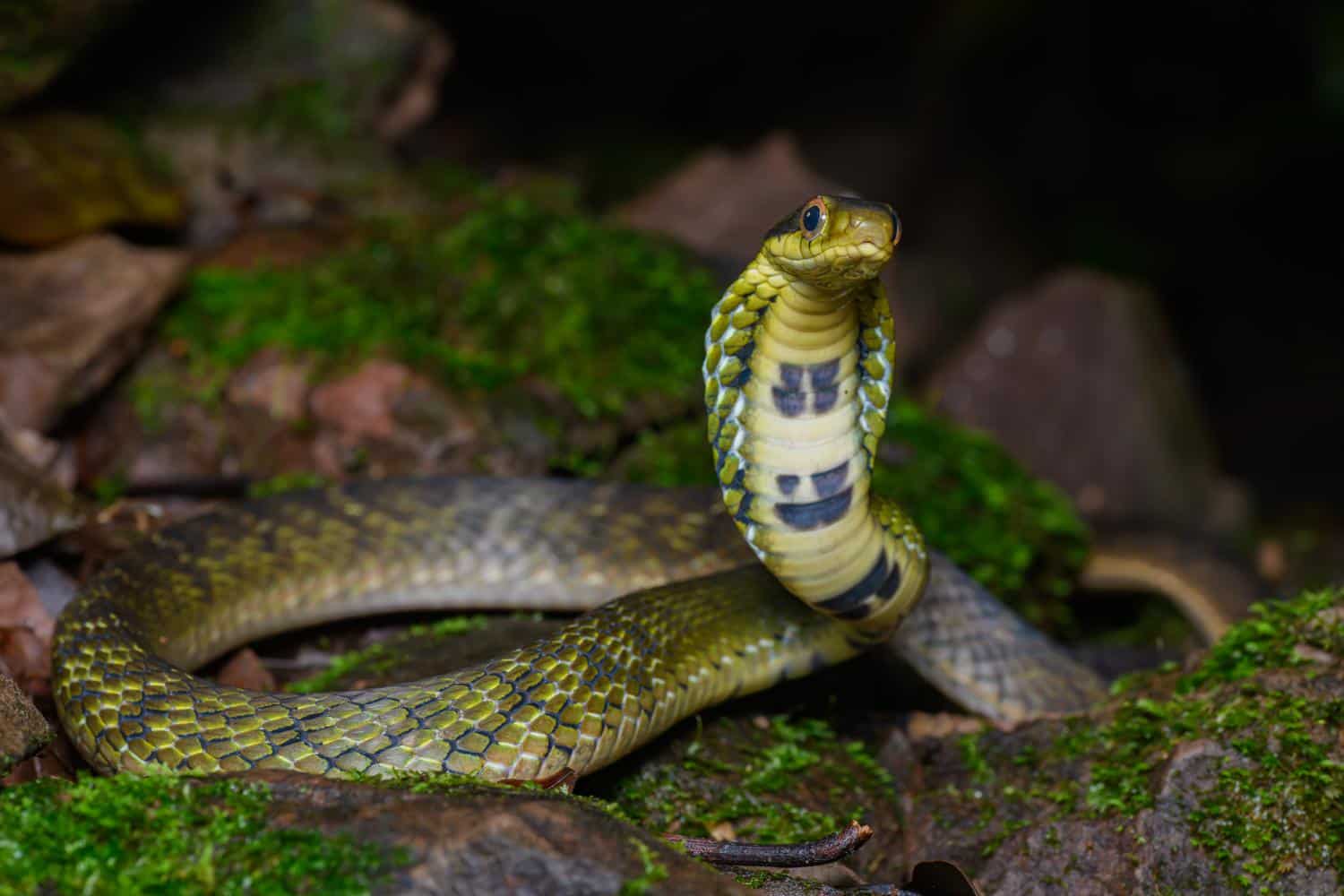
Virtually all cobras can spread a neck hood, varying in width, but a few snake species outside the family have evolved the power as well. Chief among them is the large-eyed bamboo snake (Pseudoxenodon macrops), which is widespread in China, Thailand and the eastern Himalaya. This species is only found at 900 metres or higher, typically 1200-1800 metres.
On the evolutionary tree, they have the most distant relation to true cobras possible, as they’re aren’t even Elapids, the larger venomous group containing sea snakes, coral snakes, cobras and tiger snakes. The Pseudoxenodon genus contains 6 members in southeast Asia, and their next closest relatives are the obscure Plagiopholis mountain snakes of Indonesia.
Nevertheless, the images don’t lie: Pseudoxenodon macrops can widen bones in its neck to enlarge itself horizontally by several centimetres. This simultaneously dramatically thins and flattens its throat, and reveals bright skin between the scales. It’s possible that this species evolved the hood to mimic local cobras, and gain a deceptive shield of protection, or evolved the hood independently, in order to look larger.
P. macrops is also fast-moving and darting when cornered, similarly to a real cobra. Their venom’s potency is a mystery, though is theorised to be potent. Either way, large-eyed bamboo snakes cause very few bites. Playing dead is also a trick in their defensive arsenal, but they nearly always flare their neck hood first.
| 2 | Moila (Egyptian false cobra) |
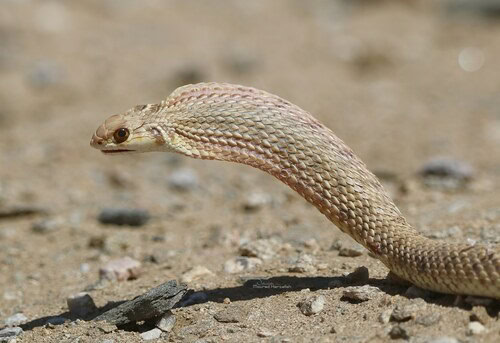
Another species with little connection to true cobras. The moila (Malpolon moilensis) inhabits North Africa and Saudi Arabia, and is most closely related to the montpellier snake, Spain’s longest snake. Moilas are smaller at an average of 60-80cm, and inhabit dry rocky areas, with shady cracks they can retreat into in hot weather. They’re venomous though poorly researched, with some keepers experiencing severe pain and swelling after mishaps.
This species is shorter, but possesses a skill Spain’s montpellier snake lacks: enlarging its ribs sideways to create a hood. Moilas prefer staying at a 45 degree angle when flaring their necks, but occasionally rear up like a true cobra. The flaring is accompanied by a piercing hiss.
Moilas are also a fast-moving, diurnal (day-faring) snake, just like real cobras. Even the shape of its mouth and the black dots for eyes are similar to a cobra. Moilas have several cobras to mimic in their local neighbourhoods, including the Nubian spitting cobra and the Egyptian cobra. The latter is easily the most widespread in North Africa, and shares the moila’s beige patterns, making the mimic extra convincing.
| 3 | Eastern hognose snake |
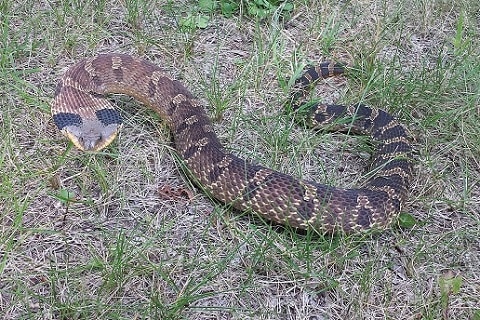
The king of US snakes for neck flares. Eastern hognose snakes are often dubbed the “spreadin’ adder” due to their ability to elongate their ribs and flare a large neck hood. Unlike a cobra, they nearly always stay parallel to the ground while flaring. They never rear up vertically, and never show off their chest, always showing the flare from the back. A hognose snake intends to make itself as large as possible from a bird’s eye view.
While eastern hognose snakes are fairly thick to begin with, they can add to their size massively by flaring their necks. Many US locals have run for their lives thinking an escaped zoo cobra is roaming the neighborhood. In reality, hognose snakes possess only a mild venom used to subdue toads. No humans deaths have ever been recorded. Flaring a neck hood is level 1 defence for this species. Level 2 is playing dead, by writhing, flipping onto their back and going deathly still, only reactivating when the human leaves.
Heterodon platirhinos reaches a maximum of 115.5cm, and appears in virtually the entire eastern US. Though western and southern hognose snakes have their rib-elongating powers, eastern hognose snakes seem to use them much more commonly. Their play-dead powers are also particularly theatrical.
| 4 | Tiger keelback |
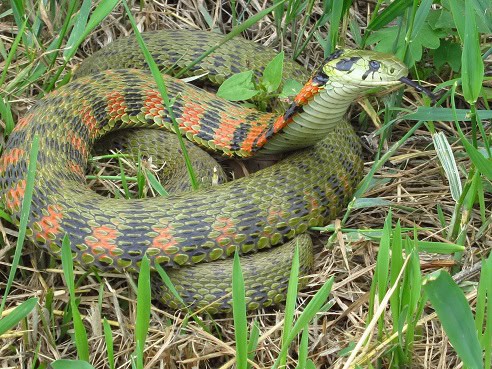
The tiger keelback (Rhabdophis tigrinius) is a common species in Japan, Taiwan, and the eastern half of China, where it sticks to moist areas like the shores of forest streams. They have the power to flare their neck by horizontally enlarging their ribs, but for a very different purpose. Tiger keelbacks have the power to store bufotoxins in special nuchal glands in their neck, by feasting on poisonous amphibians like Bankor toads and Japanese common toads. When cornered, they angle these towards the aggressor and burst them out of delicate sacs and into their face.
The purpose of enlarging their neck is to widen the colourful areas as an unmistakable threat display, to instruct the enemy to back off. When viewed from the front, they can resemble a cobra, although they’re far more colourful than the Chinese cobra, the main species they overlap with (such as in Taiwan).
According to a 2001 study, tiger keelbacks are more likely to arch their necks during cooler weather, and flee rapidly during warmer weather. This species reaches a record of 170cm, and its bite killed 4 people in Japan from 1971 to 2000.
| 5 | Angolan coral snake |
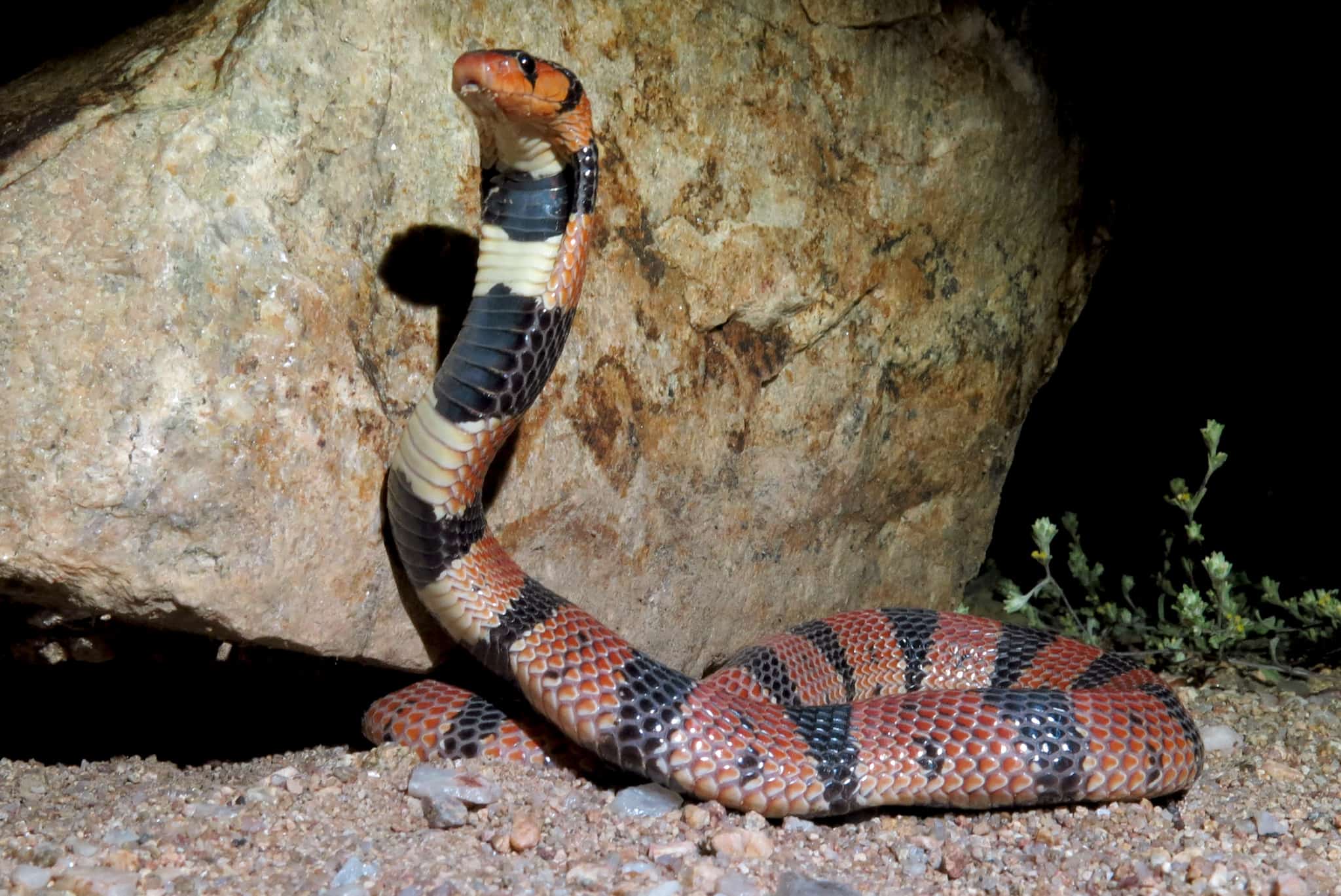
The true cobra genus of Naja has at least 25 members, but there’s also several close relatives, which are hopeful to gain admittance, yet aren’t true members of the family. For example, the king cobra is actually an isolated species, and diverged from Naja 29 million years ago. The mambas diverged 22 millions years ago. Then there’s the Angolan coral snake, which only split off from cobras 22.5 MYA. This species has diverged heavily in terms of appearance, yet has kept the signature neck flare.
Angolan coral snakes inhabit dry, rocky regions of Namibia, southern Angola and western South Africa. It rarely causes bites in humans due to its remote locations, yet has an apparently neurotoxic profile which has caused respiratory paralysis in rats. When a human meets one, typically on a road, they instantly rush up into a vertical position and flare their neck sideways, creating a small hood. They also bend their heads forward similarly to a real cobra.
Except for a few black individuals, this species could never be confused with an actual cobra. No true cobra has such colourful red-black alternating bands, contrasting with a white chest. Angolan coral snakes measure 60-75cm. They diverged from real cobras about the same time as Egypt’s black desert cobra, but that species almost never flares a hood. Black mambas occasionally flare a thin hood.
| 6 | Dull bamboo snake |
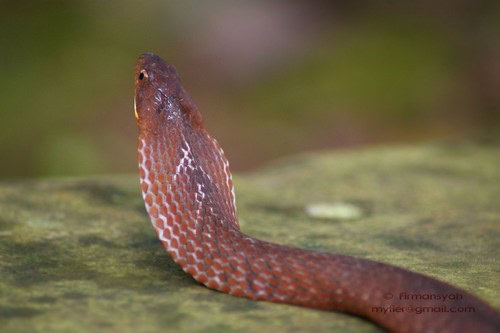
Part of the same Pseudoxenodon group as the large-eyed bamboo snake. This version inhabits Indonesia instead, and shares the same cobra-like neck hood. Dull bamboo snakes (Pseudoxenodon inornatus) are found only on the populous island of Jakarta, in bamboo thickets and submontane wet forest. One of its habitats is the forested slopes of Mount Pangrango, a dormant volcano 50 miles south of Jakarta.
Barely anything is known about the dull bamboo snake, but its spreadable hood is something any layman can identify. In normal situations, they’re thin and whip-like, for fast movements. In stressful situations, they instinctively shift rib bones in their neck sideways. As well as becoming wider, their neck becomes massively thinner. This is a brown to brown-greenish snake, which reveals whitish skin between the scales when they shift apart.
After flaring their neck hood, Pseudoxenodon members use two choices: 1) rearing up vertically and facing the enemy head on like a cobra, or 2) staying flat to the ground, similarly to a hognose snake. Dull bamboo snakes measure 50-60cm, and often have a greenish chin contrasting against a brown body.
| 7 | Red-bellied black snake |
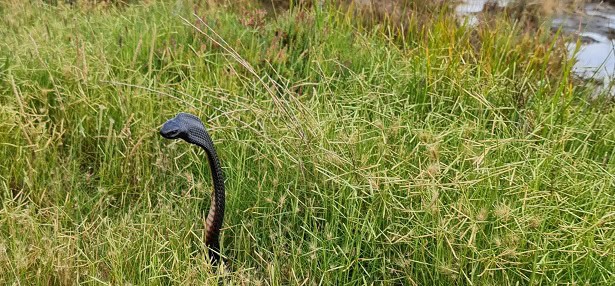
Despite being an orange wilderness of hissing snakes and venom, Australia lacks any vipers. All of its signature venomous terrors are Elapids, the same family as the cobras (and coral snakes). This includes tiger snakes, brown snakes, death adders, and small-eyed snakes. This group collectively is believed to have diverged from cobras 30-35 million years ago, yet a handful have retained the genes for neck flaring, or perhaps lost them to a dormant state, only for the trait to reemerge later.
The red-bellied black snake is found on Australia’s east coast, feeding on amphibians such as emerald spotted tree frogs, and typically inhabiting marshes, occasionally beaches. Their venom is serious, unleashing extreme pain, nausea and vomiting in humans.
To warn people of this potential fate, they helpfully rear up, and spread ribs in their upper skeleton to elongate their neck sideways. Simultaneously, they bend their neck forward to face the aggressor head on. Their chest becomes extremely thin, and the appearance is similar to the cobras they diverged from 10s of millions of years ago, and now have no overlap with (as Australia has no cobras). This snake is easy to recognise while flaring their neck, as their namesake red belly is easily visible.
| 8 | Tiger snake |
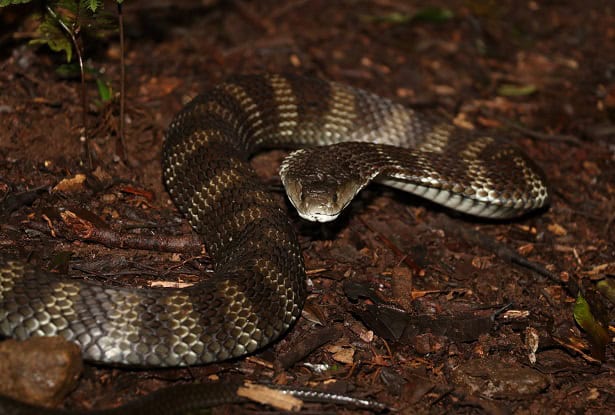
Of the Australian elapids, however, it’s the tiger snake which has the greatest neck-flaring abilities. This species inhabits southern and southeast Australia, sticking close to streams and marshes. Ordinarily, they’re moderately thin (unlike the bulky death adder), but in times of crisis, they default to making themselves look deceptively large. Tiger snakes sometimes look so wide that it’s like they’ve accidentally swallowed a school textbook. They’re capable both of massively widening their throats and flattening them, using genes evolved by their elapid ancestors in the distant past.
Tiger snakes occasionally rear up like a cobra, but they much prefer to keep their head parallel to the ground, with their upper body curved sharply. This gives them the option to instantly strike if their attempts at intimidation fail. Its venom is moderately neurotoxic, but particularly rich in procoagulants which deplete clotting materials, causing uncontrollable bleeding. Weak limbs and laboured breathing is possible in the worst affected patients, though deaths are rare since antivenom was created.
Other tiger snake skills include holding their breath for 20 minutes underwater. They occasionally reach 2 metres and are popular prey for local goshawks, kookaburras and butcherbirds, which probably explains why they stay flat while enlarging themselves, to increase their size from a bird’s eye view.
| 9 | Brazilian smooth snake |
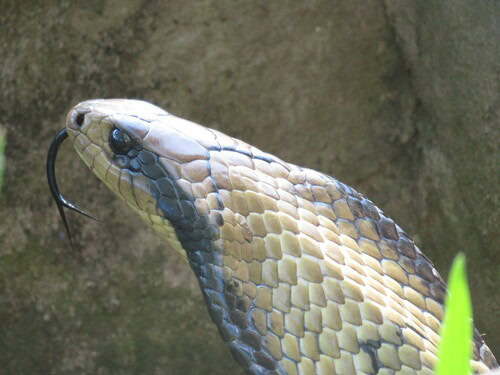
A non-venomous river cruiser found in forests of South America, which moves quickly and preys on mammals, fish and amphibians alike. Hydrodynastes gigas is most common in Paraguay, northern Argentina and southern Brazil, but can be found along river systems all over Brazil.
While only mildly venomous, this brute can reach 3 metres, and easily exceeds 2 metres. However, Brazilian smooth snakes don’t quite comprehend the terror they inspire. Despite their menacing appearance, they default to more subtle methods such as playing dead, by flipping over and going completely floppy and still. Another strategy is spreading bones in their neck to create a hood, similarly to a cobra, to fuel terror in their enemy’s hearts. This explains their alternative name – false water cobra.
Brazilian smooth snakes are a colubrid, not an elapid, and are therefore only very distant cousins of cobras (possibly diverging while dinosaurs still existed). The only other Hydrodynastes member is Hermann’s water snake, and whether this species can spread a hood is unknown. The Hydrodynastes duo is most closely related to Amaral’s ground snake (Caaeteboia amarali), a rare Brazilian forest snake, which does have the power to flatten its upper body.
| 10 | Military ground snake |

After cobras and their close cousins, the Erythrolamprus family might be the group with the highest number of hood spreaders. Erythrolamprus has 55 members, which all appear in central and South America. Most have just a mild venom, and that includes the military ground snake (E. miliaris), which can cause haemorrhaging in rats but has never caused a human death. They appear along the edges of streams, by lakes and in moist fields, and are especially concentrated along Brazil’s southeast coast such as near Sao Paulo.
If blocked, miltiary ground snakes use the typical method of enlarging their ribs, to widen their chest and neck. They even rear up similarly to a cobra (image), raising themselves vertically. The two groups diverged in the distant past, so the traits probably evolved independently.
A 2013 survey found 2 military ground snakes in Brazil’s Atlantic forest. They initially tried to flee, but whenever the photographer blocked their escape path, they spread a neck hood, predictably and consistently. The 2 snakes were an adult and juvenile, so they use the trick at all ages.
Other Erythrolamprus members confirmed to flare neck hoods include…
Velvet swamp snakes – this common Brazilian snake can also be pure blue (image).
Fire-bellied snake – this colourful species is highly concentrated in Colombia, Ecuador, Panama and eastern Costa Rica (image). Judging by the quantity of images, this member uses the trick most frequently.
Yellow-bellied liophis – the most common of the 55 Erythrolamprus members, this South American species tends to flatten its upper body while staying close to the ground (image), like a hognose snake.
